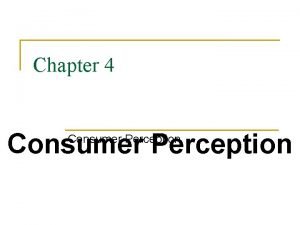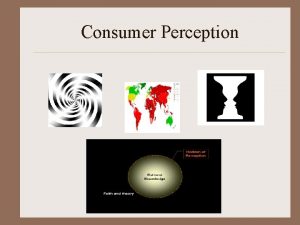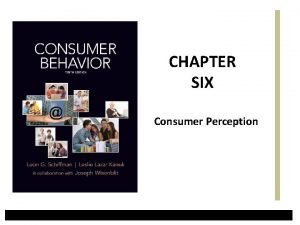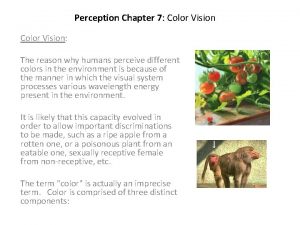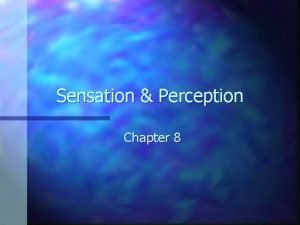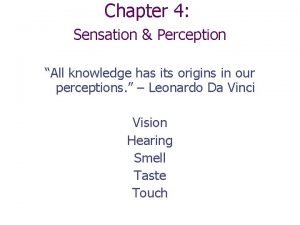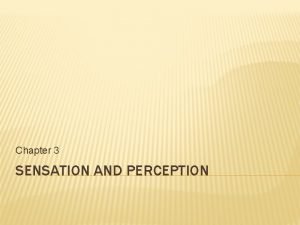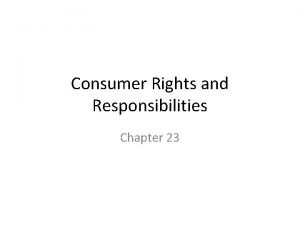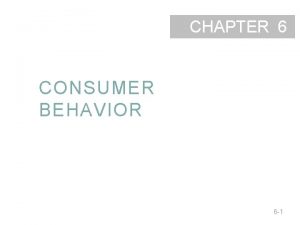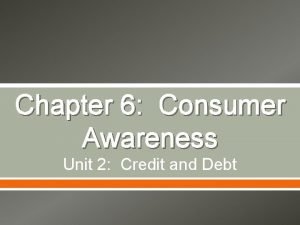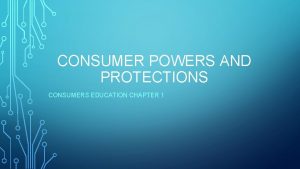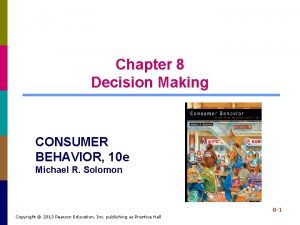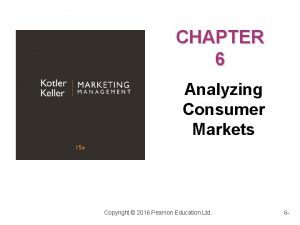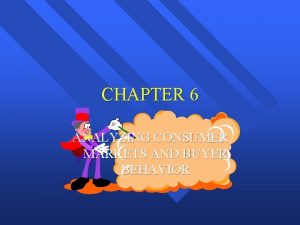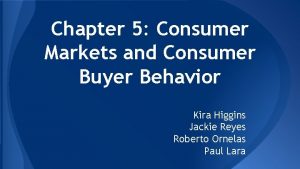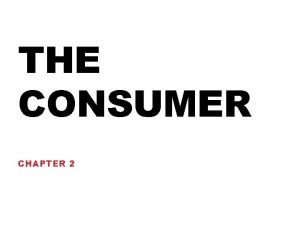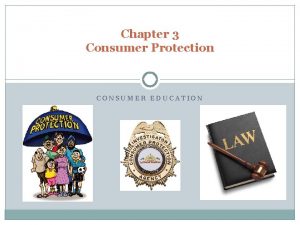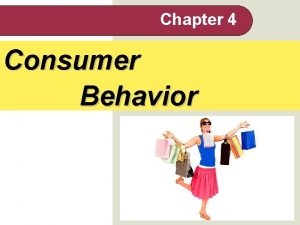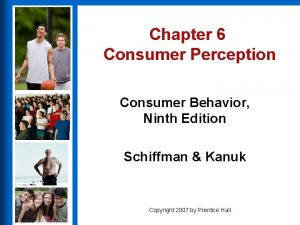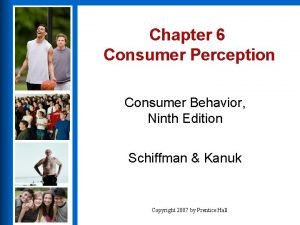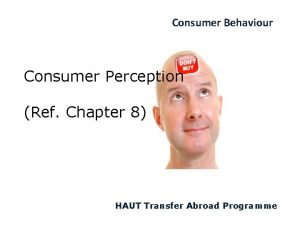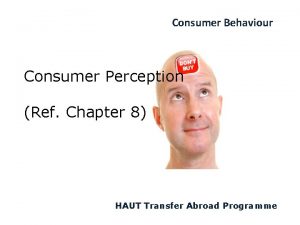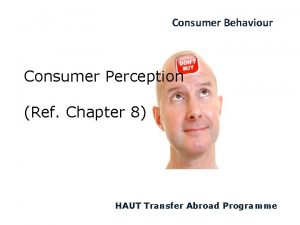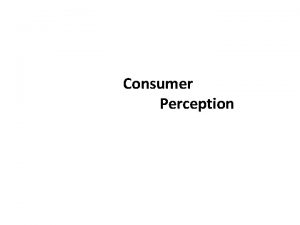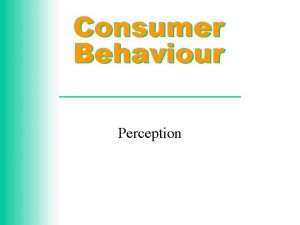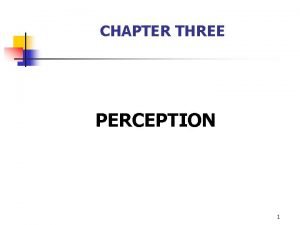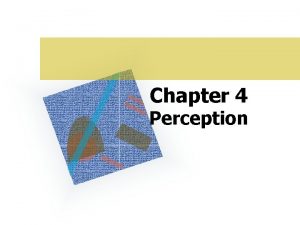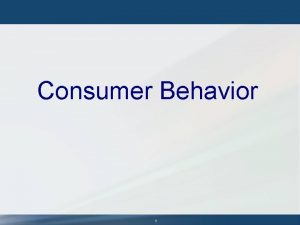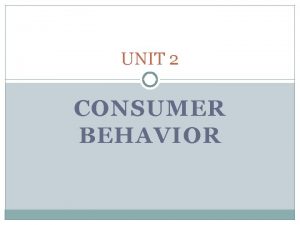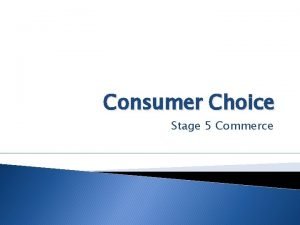Chapter 4 Consumer Perception What Is Perception n






























- Slides: 30

Chapter 4 Consumer Perception

What Is Perception? n n n The process of selecting, organizing, and interpreting sensation into a meaningful and coherent picture of the world “How we see the world around us” Two individuals may be exposed to the same stimuli but recognize, select, organize and interpret them differently based on their own needs, values and expectations

n n Consumer perceptions are vital to marketers and often underlie the success or failure of products in the marketplace In order to understand how perception affects the marketing process, we need to understand some of the basic concepts that underlie the perceptual process

Three Concepts Related to Perception n Exposure q n Attention q n The act of deliberately or accidentally coming into contact with stimuli The allocation of mental capacity to a stimulus Sensation q Responses of the sensory receptors to a stimulus and transmission of this information to the brain

Sensation n n Sensation is the immediate and direct response of the sensory organs to simple stimuli The human organs that receive sensory inputs are called sensory receptors

Sensory Systems Eye Ear Nose Mouth Skin Sight Sound Smell Taste Touch Exposure to Raw Data Processing of Inputs Interpretation of Inputs

Vision n n Vision is the dominant human sense, so we know more about it than the other senses Vision is known to stimulate physiological changes q q n n Warm hues (red, orange) increase blood pressure and heart rate Cool hues (blue, green) have the opposite effect Orange is used in fast food restaurants to increase hunger Blues and greens are used in hospitals to reduce patient anxiety

Smell n n Smell is the most direct of the senses No sense evokes memory more than smell Exposure to odors remembered from childhood can induce mood effects like those experienced in childhood Marketers understand this and build mood effects into products through odors

n Research has shown that a pleasant odor increases lingering and the amount of time spent in a store

Taste n n Taste has an obvious impact on the success of food and beverages North Americans appear to have a preference for fatty foods Thus the success of fast food and pizza restaurants Culture plays a powerful role in determining taste

Sound n n n Sound, in the form of speech and music, is important to marketers Research shows a positive connection between the use of popular songs in ads and consumers’ recall of those ads Research also shows a positive connection between music and store sales and a negative connection between noise and sales

Touch n Physical contact with a product often provides consumers with vital information

Input Variation and Sensation n Changes in what we feel, hear, see, etc. at any given time As input increases, the ability to distinguish differences decreases As input decreases, the ability to distinguish differences increases

n n n Perceptual overloading: the inability to perceive all competing stimuli for one’s attention Perceptual vigilance: the ability to disregard much of the stimulation one receives Consumers easily ignore ads when bombarded by them constantly

Perceptual Selection n Each day consumers are surrounded by stimuli They are able to subconsciously exercise selectivity over which stimuli they perceive Which stimuli are selected depend on two major factors q q Consumers’ previous experience (what they are prepared to see) Their motives (needs, desires, interests, etc. )

Some Important Concepts Regarding Selective Perception n Selective Exposure q n Consumers actively seek out messages they find pleasant or are sympathetic to and avoid painful or threatening ones Selective Attention q Consumers exercise selectivity over attention given to commercial stimuli; they have a heightened awareness of stimuli that meet needs/interests and minimal awareness of irrelevant stimuli Environmental Stimuli Selective Exposure Selective Attention Perception

Selective Interpretation n q The interpretation of stimuli is also uniquely individual, because it is based on what people expect to see in light of previous experience, their motives and interests

n Adaptation Levels q n Indifference to a stimulus to which one has become accustomed Attention Stimulation q Placement, timing, and presentation of stimuli so that target consumers are most likely exposed to them

Threshold Levels of Perception n Sensation is the immediate and direct response of the sensory organs (e. g. , eyes, ears, etc. ) to a stimulus (e. g. , an ad, a package, a brand name) Sensation is provoked by changes in sensory input The more stimuli that are present, the greater the change must be, and vice versa (e. g. , pin dropping)

n 1. 2. For marketers’ purposes, there are two levels of sensory input (thresholds) of importance: Absolute threshold Differential threshold (“just noticeable difference”)

. 1 The absolute threshold n n The lowest level at which an individual can experience a sensation I. e. , the lowest level of stimuli at which a person can detect a difference between something and nothing

n n Over time and exposure, the absolute threshold drops as consumers “get used to” a stimulus (sensory adaptation) Marketers need to increase/change sensory input in order to keep the attention of their target market

2. Differential Threshold (JND) n n n The minimum change in sensation necessary for a person to detect it 19 th century German scientist Ernst Weber discovered that the JND between two stimuli was not absolute, but varied according to the intensity of the first stimulus Weber’s Law thus states that the greater the initial stimulus, the greater the additional stimulus needs to be in order to be noticeable

Implications for marketers n n 1. 2. Manufacturers and marketers try to determine the JND for their products There are two primary reasons So that negative changes (e. g. , reduction in product size or quality or increases in price) are noticeable So that product improvements (improved packaging, larger quantities, lower price) are very apparent

Ethical issue n n n Reductions in quantity and size may not be reflected in different packaging Marketers may attempt to differentiate product lines that are minimally different by increasing price differences between the lines Thus consumers perceive the lines as different when they are not

Perception and Image n n The view or portrait of a product, brand, store or company created in consumers’ minds Image is a major factor in consumers’ choice of one brand or store over another

n n n n Images may be created around a number of categories: Economy Safety Reliability Pleasure Status Distinctiveness

Subliminal Perception n Research shows that people are stimulated below their level of conscious awareness—they can perceive stimuli without being consciously aware they are doing so Federal Communications Commission was concerned enough to ban it from television and radio http: //www. snopes 2. com/business/hidden/popcorn. h tm

n n In the 70’s interest was renewed due to claims advertisers were using subliminal embeds in print ads The most common claims involved the use of suggestive symbols in ice cubes floating in a pictured drink Research indicates sexually oriented embeds do not influence consumer preferences Because there is no evidence it works, there are no laws or regulations prohibiting it

Link to Subliminal Advertising Websites http: //www. subliminalworld. com/
 Primary secondary tertiary consumers
Primary secondary tertiary consumers Perceptionn
Perceptionn Consumer perception process
Consumer perception process Objectives of consumer perception
Objectives of consumer perception Decomposer in the sahara desert
Decomposer in the sahara desert Consumer diversity in consumer behaviour
Consumer diversity in consumer behaviour Consumer behaviour research process
Consumer behaviour research process Consumer markets and consumer buyer behavior
Consumer markets and consumer buyer behavior Changes in an individual's behavior arising from experience
Changes in an individual's behavior arising from experience Chapter 5 sensation and perception
Chapter 5 sensation and perception Chapter 7 vision and perception
Chapter 7 vision and perception Chapter 3 sensation and perception
Chapter 3 sensation and perception Chapter 6 sensation and perception
Chapter 6 sensation and perception Psychology chapter 4 sensation and perception
Psychology chapter 4 sensation and perception Kinesthetic sense
Kinesthetic sense Chapter 8 sensation and perception
Chapter 8 sensation and perception Horizontal e vertical
Horizontal e vertical Chapter 4 sensation and perception
Chapter 4 sensation and perception Chapter 3 sensation and perception
Chapter 3 sensation and perception Responsibilities of a consumer
Responsibilities of a consumer The right to have problems corrected
The right to have problems corrected Consumption situation
Consumption situation Chapter 6 consumer behavior
Chapter 6 consumer behavior Consumer awareness unit test
Consumer awareness unit test Chapter 1 consumer powers and protections
Chapter 1 consumer powers and protections Consumer behavior chapter 8
Consumer behavior chapter 8 Chapter 6 consumer behavior
Chapter 6 consumer behavior Analyzing consumer markets chapter 6
Analyzing consumer markets chapter 6 Chapter 5 consumer markets and buyer behavior
Chapter 5 consumer markets and buyer behavior Taking charge of your health chapter 2
Taking charge of your health chapter 2 Consumer behavior chapter 1
Consumer behavior chapter 1

